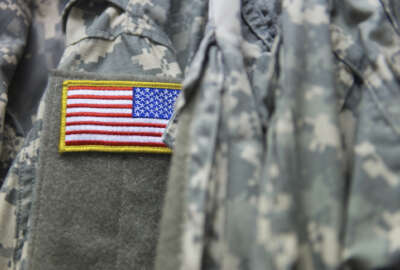Army wants more Guard, Reserve deployments in 2017
The Army's 2017 budget would roughly double the funding line which pays for involuntary mobilizations of selected reservists within the National Guard and Army...
Citing ongoing readiness strains within its active duty force, the Army is asking Congress for permission for a significant uptick in its use of National Guard and Army Reserve forces to handle missions in combatant commands throughout the world.
The service’s 2017 budget requests a near-doubling in the Army funding line that pays for involuntary mobilizations of selected reserve forces to conduct pre-planned missions for up to a year compared with the amount officials requested in 2016. Measured in “man-years,” the funding —referred to as 12304(b) — would jump from 1,008 in 2016 to 1,878 in 2017.
“We need more flexible access to the reserve component, specifically for emerging missions,” Gen. Daniel Allyn, the Army’s vice chief of staff, told the House Armed Services Committee Friday. “Where the stress is really starting to press down on our active formations is in meeting emerging requirements where we have time constraints that don’t let us prepare and deploy a reserve component unit to meet the requirement. So this gives us greater flexibility to leverage that great reserve component capacity for missions beyond just those that are funded through overseas contingency operations. For instance, Pacific Pathway exercises would be a perfect match, but we don’t have the funding authorizations.”
The Army would deploy the reserve forces to all six of DoD’s geographic combatant commands. In U.S. Southern Command, for instance, their missions would include hunting for terrorist cells in Central America and the Caribbean. In Africa they’d work on military training and education with regional governments. In Central Command and European Command, they would “support the international civil presence to prevent any violation of established treaties.”
The request for increased deployments of guardsmen and reservists comes amid growing concerns that the Army’s current plan to draw down its active component to 450,000 soldiers would put an unsustainable strain on its full-time force, considering the tempo at which it’s still operating around the world. The 12304(b) authority, created by Congress in 2002, lets the Army deploy up to 60,000 reservists for up to a year at a time without counting against statutory caps on its active force — as long as it’s adequately funded.
“From now through at least 2020, the primary limiting factor for us achieving full spectrum readiness is our personnel manning,” Allyn said. “The turbulence that we are undergoing as we reorganize our Army as a smaller, more capable force has created additional turbulence on top of that which is driven by our drawdown. And it is being borne by lower manning levels across our formations. During the war, we were able to man in our units above 100 percent in order to ensure they deployed as fully manned as possible. With a 10 percent non-ready force across the total force today, we cannot sustain that. So, manning is a critical limiting factor for us, and it is exacerbated by the growth in current operations demands for our Army.”
Allyn said the Army delivers about 46 percent of the military manpower the combatant commands request for preplanned operations each year plus 64 percent of the forces that are sent for unexpected needs — more than all the other military services combined. He said so far, the Army has largely been able to meet those requests, but at the expense of being able to quickly “surge” for potential contingency operations.
As one example of how the added call-ups of selected reservists would work, the Army would ease the strain on its active duty brigade combat teams by adding some National Guard brigades to their rotations. Active brigades are currently deployed one year for every 1.6 years they spend at home. As a matter of DoD policy, the goal for all active units is a “deployment to dwell” ratio of one-to-two.
Latest Army News
Lt. Gen Joseph Anderson, the deputy chief of staff for operations and plans, said several Guard brigades are sufficiently trained to fulfill missions currently being handled by active forces, including the Minnesota National Guard’s 1st Armored Brigade Combat Team and the Idaho National Guard’s 116th Cavalry Brigade Combat Team.
“That’s our top two tier Guard BCTs. So how can we grab them and use them? We need Guard divisions and Guard BCTs to lessen our deployment-to-dwell,” he said. “The only way we’re going to do that, assuming that our emergent and our continuing requirements stay about the same is to use the National Guard.”
In its recently-released final report, the National Commission on the Future of the Army said Congress must do more to let the Army manage its active and reserve components as a total force, including by expanding the use of 12304(b) authority and paying for it.
“The impact of budgetary cuts has effectively limited the Army’s ability to provide Army National Guard and Army Reserve forces to meet Combatant Command requirements. Off-ramp decisions to avoid costs after scheduling Army National Guard units for deployment increased friction and, in some cases, raised suspicions between components that other motives were in play,” commissioners wrote. “The Total Force Policy must be resourced if it is going to be effective, and the absence of adequate 12304(b) funding will limit using Army National Guard and Army Reserve forces on missions for which they are ideally suited. Meanwhile, such cost avoidance decisions increase operational tempo for many Regular Army units that may not have sufficient home station dwell time.”
Copyright © 2024 Federal News Network. All rights reserved. This website is not intended for users located within the European Economic Area.
Jared Serbu is deputy editor of Federal News Network and reports on the Defense Department’s contracting, legislative, workforce and IT issues.
Follow @jserbuWFED





